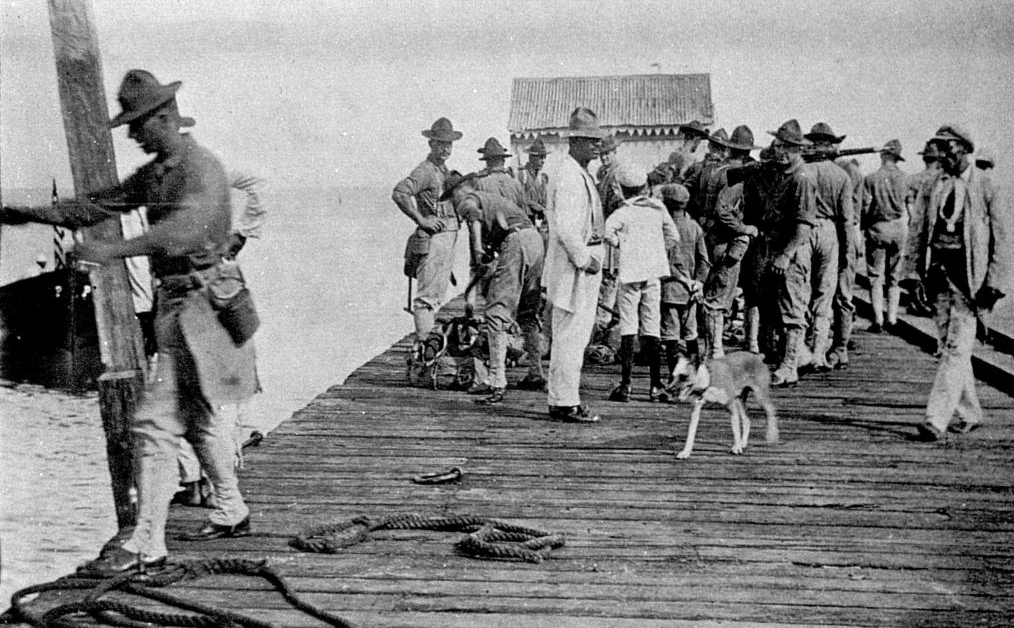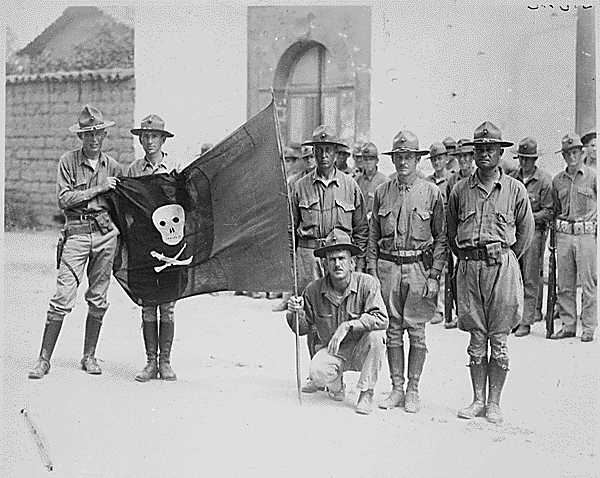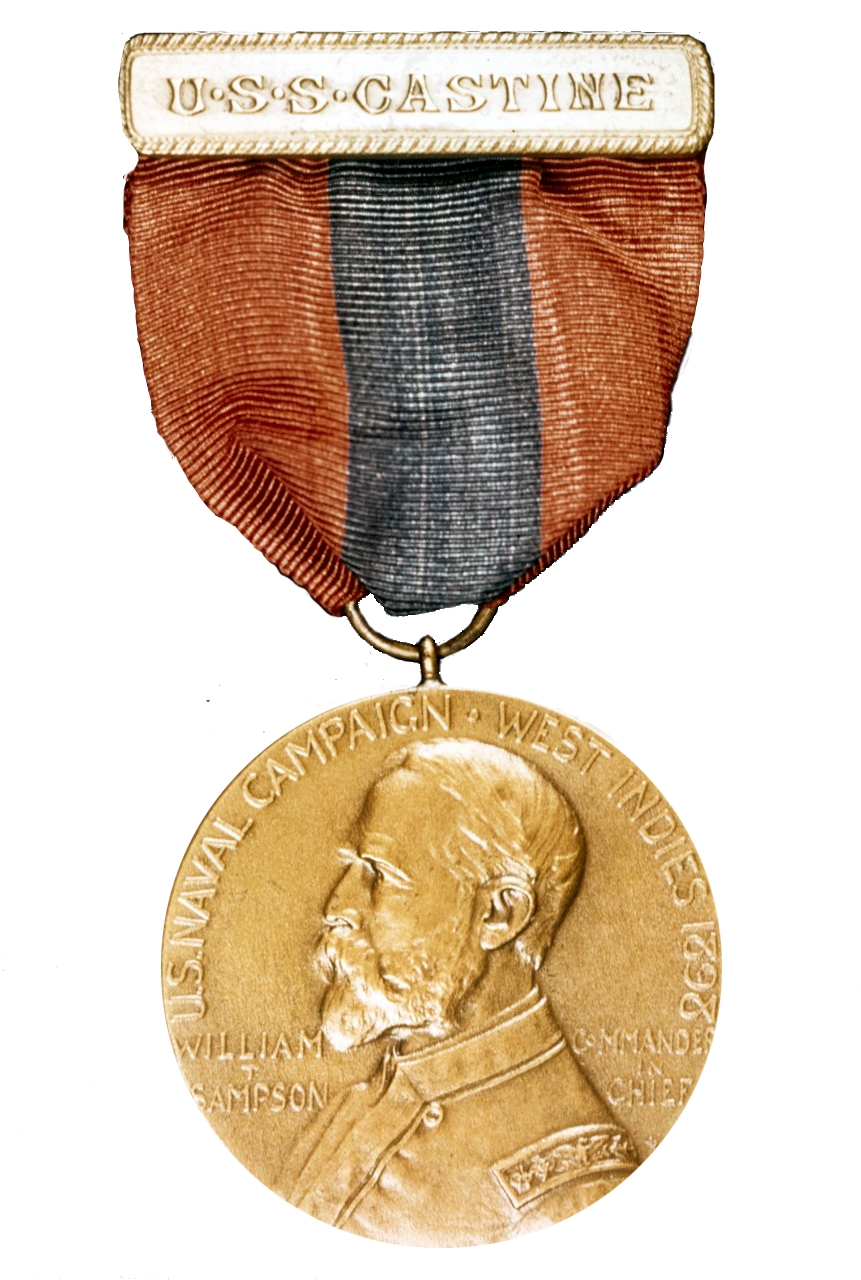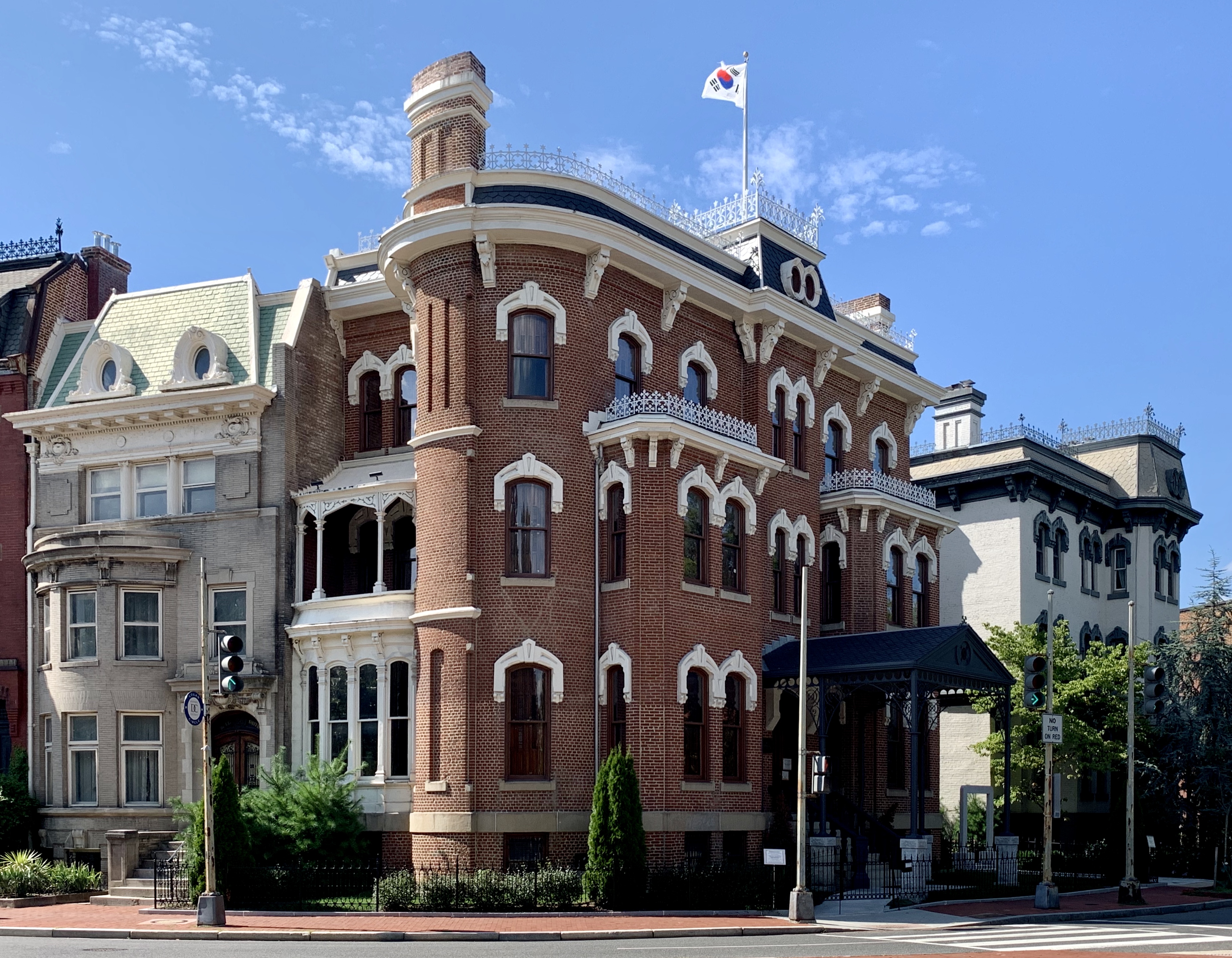|
United States Occupation Of The Dominican Republic (1916–1924)
The first United States occupation of the Dominican Republic lasted from 1916 to 1924. It was one of the many interventions in Latin America undertaken by the military forces of the United States in the 20th century. On May 13, 1916, Rear Admiral William B. Caperton forced the Dominican Republic's Secretary of War Desiderio Arias, who had seized power from President Juan Isidro Jimenes Pereyra, to leave Santo Domingo by threatening the city with naval bombardment. The Marines landed three days later and established effective control of the country within two months. The U.S. occupations of Haiti and the Dominican Republic led to clashes that killed 290 U.S. Marines, over 3,000 Haitians, and hundreds of Dominicans. Despite having much greater firepower, it took the U.S. Marines five years to suppress an insurgency in the eastern provinces of El Seibo and San Pedro de Macorís. Invasion The piecemeal invasion resulted in the United States Navy's occupation of all key positions ... [...More Info...] [...Related Items...] OR: [Wikipedia] [Google] [Baidu] |
Banana Wars
The Banana Wars were a series of conflicts that consisted of military occupation, police action, and intervention by the United States in Central America and the Caribbean between the end of the Spanish–American War in 1898 and the inception of the Good Neighbor Policy in 1934. The military interventions were primarily carried out by the United States Marine Corps, who also developed a manual, the '' Small Wars Manual'' (1921) based on their experiences. On occasion, the United States Navy provided gunfire support and troops from the United States Army were also deployed. With the Treaty of Paris signed in 1898, control of Cuba, Puerto Rico, Guam, and the Philippines fell to the United States (surrendered from Spain). Following this, the United States proceeded to conduct military interventions in Cuba, Panama, Honduras, Nicaragua, Mexico, Haiti, and the Dominican Republic. These conflicts ended with the withdrawal of troops from Haiti in 1934 under President Franklin D. Roo ... [...More Info...] [...Related Items...] OR: [Wikipedia] [Google] [Baidu] |
United States Occupation Of Haiti
The United States occupation of Haiti began on July 28, 1915, when 330 U.S. Marines landed at Port-au-Prince, Haiti, after the National City Bank of New York convinced the President of the United States, Woodrow Wilson, to take control of Haiti's political and financial interests. The invasion and subsequent occupation was promoted by growing American business interests in Haiti, especially the National City Bank of New York, which had withheld funds from Haiti and paid rebels to destabilize the nation through the Bank of the Republic of Haiti in actions aimed at inducing American intervention. The July 1915 invasion took place following years of socioeconomic instability within Haiti that culminated with the lynching of President of Haiti Vilbrun Guillaume Sam by a mob angered by his decision to order the executions of political prisoners. The occupation ended on August 1, 1934, after President Franklin D. Roosevelt reaffirmed an August 1933 disengagement agreement. Th ... [...More Info...] [...Related Items...] OR: [Wikipedia] [Google] [Baidu] |
Single-shot
Single-shot firearms are firearms that hold only a single round of ammunition, and must be reloaded manually after every shot. The history of firearms began with single-shot designs, then multi-barreled designs appeared, and eventually many centuries passed before multi-shot repeater designs became commonplace. Compared to repeating firearms, single-shot designs have no moving parts (other than the trigger and hammer/firing pin or frizzen) and thus do not need a sizable receiver behind the barrel, and are much less complex than revolvers or magazine/belt-fed firearms. Although largely disappeared from military usage due to the slow rates of fire, single-shot designs are still produced by many manufacturers in both cartridge- and non-cartridge varieties, from zip guns to the highest-quality hunting and match guns. History Pre-cartridge era The vast majority of firearms before the introduction of metallic cartridges from the 1860s onwards, were single-shot muzzleloaders ... [...More Info...] [...Related Items...] OR: [Wikipedia] [Google] [Baidu] |
Santiago De Los Caballeros
Santiago de los Caballeros (; '' en, James, son of Zebedee, Saint James of the Knights''), often shortened to Santiago, is the second-largest city in the Dominican Republic and the fourth-largest city in the Caribbean by population. It is the capital of Santiago Province (Dominican Republic), Santiago Province and the largest major metropolis in the Cibao region of the country, it is also the largest non-coastal metropolis in the Caribbean islands. The city has a total population of 1,173,015 inhabitants. Santiago is located approximately northwest of the capital Santo Domingo with an average altitude of 178 meters (584 ft). Founded in 1495 during the first wave of European colonization of the Americas, European settlement in the New World, the city is the "first Santiago (other), Santiago of the Americas". Today it is one of the Dominican Republic's cultural, political, industrial and financial centers. Due to its location in the fertile Cibao Valley it has a robus ... [...More Info...] [...Related Items...] OR: [Wikipedia] [Google] [Baidu] |
Monte Cristi, Dominican Republic
San Fernando de Monte Cristi is the capital town of Monte Cristi Province in the Dominican Republic. It is located in the northwest region of the country in a coastal area above the border with Haiti. History Monte Cristi was founded by Nicolás de Ovando in 1506 and populated in 1533 by Juan de Bolaños and 63 families from the Canary Islands. These migrated to various parts of the country afterwards leaving the town behind. It was later repopulated and became a very wealthy port in the mid-to-late 16th century. In 1606, one hundred years after its founding, it was destroyed as retribution for doing business with pirates. In 1756 the city was rebuilt and again became a prosperous trading center, until the early 20th century. In 1895, it was the site of the signing of the Manifesto of Montecristi by Máximo Gómez and José Martí, at the Gómez home on Mella St. They sailed from "La Granja" beach, also in Montecristi, to Cuba to fight for its independence. Climate Mon ... [...More Info...] [...Related Items...] OR: [Wikipedia] [Google] [Baidu] |
Puerto Plata, Dominican Republic
Puerto Plata, officially known as San Felipe de Puerto Plata, is the third-largest city in the Dominican Republic, and capital of the province of Puerto Plata. The city is a trading port. Puerto Plata has resorts such as Playa Dorada and Costa Dorada, which are located east of the city proper. There are 100,000 hotel beds in the city. The first aerial tramway of the Caribbean is located in Puerto Plata, in which visitors can ride up to the Pico Isabel de Torres, a 793-meter (2600-foot) high mountain within the city. The fortification Fortaleza San Felipe, which was built in the 16th century and served as a prison under Rafael Trujillo's dictatorship, lies close to the port of Puerta Plata. The Amber Museum is also a well-known attraction in this city. La Isabela, a settlement built by Christopher Columbus, is located near Puerto Plata. In April 1563, the Spanish settlement became notorious when the English slave trader Sir John Hawkins brought 400 people he had abducted from Sie ... [...More Info...] [...Related Items...] OR: [Wikipedia] [Google] [Baidu] |
Juan Isidro Jimenes
Juan Isidro Jimenes Pereyra (November 15, 1846 – May 9, 1919) was a Dominican political figure. He served as the president of the Dominican Republic between 15 November 1899 and 2 May 1902, and again between 5 December 1914 and 7 May 1916. Jimenes was one of the main leaders of the Los Bolos, Blue party or Jimenistas, opposed to the Los Coludos or Horacistas, led by Horacio Vásquez. He was married to Josefa de los Santos Domínguez. Los Santos spoke French and read poetry and spiritual books. He is buried in the Catedral de Santa María la Menor Catedral may refer to: * Catedral (Buenos Aires Underground), a station * Catedral (district), a district of the San José canton, in the San José province of Costa Rica * Cerro Catedral, a mountain and ski resort in Argentina * Cerro Catedral (U .... References External links * , - , - 1846 births 1919 deaths 19th-century Dominican Republic politicians 20th-century Dominican Republic politicians People f ... [...More Info...] [...Related Items...] OR: [Wikipedia] [Google] [Baidu] |
USS Castine (PG-6)
USS ''Castine'' (PG-6) was a gunboat of the United States Navy in commission from 1894 to 1901, from 1903 to 1905, and from 1908 to 1919. The first U.S. Navy ship named for Castine, Maine, she saw service during the Spanish–American War, the Philippine–American War, and World War I. Construction and commissioning ''Castine'' was launched on 11 May 1892 by Bath Iron Works in Bath, Maine, sponsored by Ms. M. Hichborn. She was commissioned on 22 October 1894 with Commander Thomas Perry in command, and reported to the United States Atlantic Fleet. Service history Pre-Spanish American War Assigned to the South Atlantic Ocean, ''Castine'' cleared New England waters in February 1895. She called at the Azores and Gibraltar, passed through the Suez Canal, visited Zanzibar and Mozambique, and rounded the Cape of Good Hope before arriving on station at Pernambuco, Brazil, on 13 October 1895. She cruised in South American and West Indian waters – save for an overhaul period ... [...More Info...] [...Related Items...] OR: [Wikipedia] [Google] [Baidu] |
Legation
A legation was a diplomatic representative office of lower rank than an embassy. Where an embassy was headed by an ambassador, a legation was headed by a Envoy Extraordinary and Minister Plenipotentiary, minister. Ambassadors diplomatic rank, outranked ministers and had precedence at official events. Legations were originally the most common form of diplomatic mission, but they fell out of favor after World War II and were upgraded to embassies. Through the 19th century and the early years of the 20th century, most diplomatic missions were legations. An ambassador was considered the personal representative of their monarch, so only a Great power, major power that was a monarchy would send an ambassador, and only to another major power that was also a monarchy. A republic or a smaller monarchy would only send a minister and establish a legation. Because of diplomatic reciprocity, even a major monarchy would only establish a legation in a republic or a smaller monarchy. For example, ... [...More Info...] [...Related Items...] OR: [Wikipedia] [Google] [Baidu] |
USS Prairie (AD-5)
USS ''Prairie'' (AD-5), formerly Morgan Liner SS ''El Sol'', was built in 1890 by William Cramp & Sons, Philadelphia. She was purchased by the United States Navy on 6 April 1898 from the Southern Pacific Company, and commissioned two days later at New York, Commander Charles J. Train in command. History ''Prairie'' was converted into an auxiliary cruiser and assigned at first to the Northern Patrol Squadron and later to the North Atlantic Fleet. During the Spanish–American War, she served in Cuban waters July and August 1898. On 25 August she stranded in dense fog 3 miles east of the Amagansett, New York Life saving Station. The United States Life Saving Service ferried 216 troops to shore. She was pulled off the next day by the tug ''Brittania''. She returned to Fore River, Massachusetts on 28 August. She decommissioned on 15 March 1899 at Philadelphia. ''Prairie'' was placed in reserve commission on 23 March 1899 and cruised with the naval militia off the Atlantic coast ... [...More Info...] [...Related Items...] OR: [Wikipedia] [Google] [Baidu] |
The United States Marine Corps
The United States Marine Corps (USMC), also referred to as the United States Marines, is the maritime land force service branch of the United States Armed Forces responsible for conducting expeditionary and amphibious operations through combined arms, implementing its own infantry, artillery, aerial, and special operations forces. The U.S. Marine Corps is one of the eight uniformed services of the United States. The Marine Corps has been part of the U.S. Department of the Navy since 30 June 1834 with its sister service, the United States Navy. The USMC operates installations on land and aboard sea-going amphibious warfare ships around the world. Additionally, several of the Marines' tactical aviation squadrons, primarily Marine Fighter Attack squadrons, are also embedded in Navy carrier air wings and operate from the aircraft carriers. The history of the Marine Corps began when two battalions of Continental Marines were formed on 10 November 1775 in Philadelphia as a serv ... [...More Info...] [...Related Items...] OR: [Wikipedia] [Google] [Baidu] |
United States Navy
The United States Navy (USN) is the maritime service branch of the United States Armed Forces and one of the eight uniformed services of the United States. It is the largest and most powerful navy in the world, with the estimated tonnage of its active battle fleet alone exceeding the next 13 navies combined, including 11 allies or partner nations of the United States as of 2015. It has the highest combined battle fleet tonnage (4,635,628 tonnes as of 2019) and the world's largest aircraft carrier fleet, with eleven in service, two new carriers under construction, and five other carriers planned. With 336,978 personnel on active duty and 101,583 in the Ready Reserve, the United States Navy is the third largest of the United States military service branches in terms of personnel. It has 290 deployable combat vessels and more than 2,623 operational aircraft . The United States Navy traces its origins to the Continental Navy, which was established during the American Revo ... [...More Info...] [...Related Items...] OR: [Wikipedia] [Google] [Baidu] |







